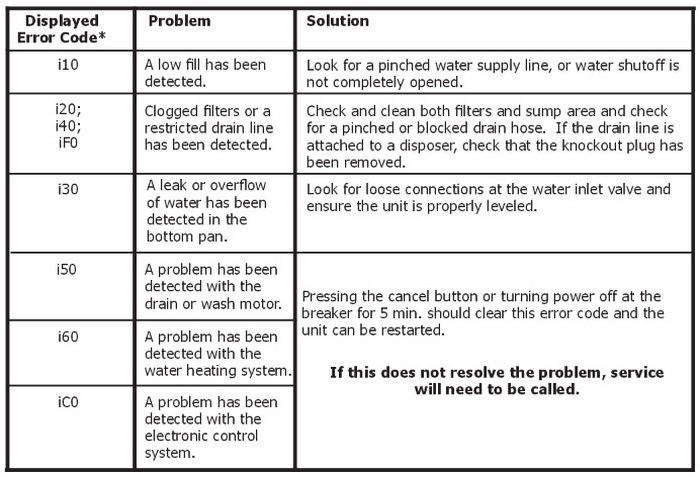
Here’s the deal: error codes in dishwashers, like the E2 in Frigidaire models, are a way for your appliance to let you know something’s gone awry. It’s a bit like the “check engine” light in your car. Sure, you could keep driving, but without knowing the issue, you might be heading for bigger problems down the road. In the case of the E2 code, it’s typically related to a drainage problem. So, let’s dive deeper to understand what’s happening when you see this pesky code and whether you can safely ignore it or not.
Understanding the E2 Error Code
When you see the E2 error on your Frigidaire dishwasher, it’s essentially telling you there’s a drainage issue. Imagine trying to fill up a sink with water, but the plug isn’t in properly, so the water just keeps running out. That’s similar to what your dishwasher is experiencing. The E2 code suggests that your dishwasher isn’t able to drain out used water effectively. This can be due to a clogged hose, a malfunctioning drain pump, or even a kinked drain line.
A dishwasher’s drainage system is crucial for its operation. Without proper drainage, dirty water remains stagnant, potentially leading to odor issues or even damage to your machine over time. Ignoring this code means risking those dirty water woes, which can make a simple cleanup job turn into a kitchen nightmare. Don’t worry, though. By understanding the system’s basics, you can tackle this issue without needing to call in the pros immediately.
Now, let’s translate this tech talk into everyday terms. Think of your dishwasher’s drainage as similar to a bathtub. If the drain gets blocked, the water won’t go away until you unclog the drain. The E2 error is like the warning sign telling you there’s a problem under the water. So shrugging it off might not be the best course of action unless you want to end up with a kitchen floor full of sudsy water.
Why You Shouldn’t Ignore That Error
So, can you ignore the E2 error on your dishwasher? It’s tempting to look the other way and hope the problem resolves itself. Unfortunately, that’s not usually the best course of action here. Ignoring this error could exacerbate the problem, leading to water damage in your kitchen or a buildup of bacteria and grime in your dishwasher.
Think about it like this: if you ignore a small leak in your roof during a rainy season, soon it could become a gaping hole! With dishwashers, the longer you leave the E2 code unaddressed, the more likely you’re going to face more expensive repairs or even need to replace parts of your appliance. Not to mention, your dishes will definitely not come out sparkling clean if they’re being washed in old, dirty water.
Even though it may feel like just a minor inconvenience, taking action now can prevent future headaches. Consider it a small investment of time that will keep your kitchen running smoothly. Think of yourself as the hero in this story—by tackling the problem at its root, you’re not only preventing future issues but also ensuring your peace of mind.
Troubleshooting the E2 Error
Okay, you’re ready to roll up your sleeves and tackle this problem. But where to start? Don’t worry, you don’t need to be a certified plumber to get your dishwasher back on track. First, check the drain hose for any clogs or kinks. If it’s twisted like a pretzel, your dishwasher won’t be able to expel water properly. Straighten it out and see if that resolves the issue.
If the hose looks fine, the next step is to inspect the dishwasher’s filter and drain pump for any debris. Just like lint in your dryer, food particles can get stuck and block the flow of water. Cleaning these parts might just be the simple fix you need. A word of caution: always turn off the power before you start poking around inside your dishwasher. Safety first!
Lastly, if these steps don’t clear up the E2 issue, it might be time to consult your trusty user manual or call in a professional. Sometimes, the problem could stem from a deeper issue that requires expert attention. And hey, there’s no shame in getting a little help when you need it. Remember, you’re doing all this to ensure your dishwasher runs smoothly and your dishes come out squeaky clean.
Preventing Future Error Codes
Let’s talk prevention. After all, wouldn’t it be nice to avoid seeing that E2 code ever again? Regular maintenance is key. Just like you wouldn’t go years without changing your car’s oil, your dishwasher needs a little TLC too. Routinely cleaning the filter, checking the hoses for blockages, and running a cleaning cycle every so often can keep things running smoothly.
Think of this maintenance as giving your dishwasher a spa day. It relaxes your appliance and makes sure it’s in peak condition, ready to tackle dirty dishes head-on. By keeping your dishwasher well-maintained, you’re not only preventing the E2 error but also extending the lifespan of your appliance.
It might seem like a lot at first, but trust me—your future self will thank you. The time you spend on maintenance now is time saved trying to frantically figure out error codes later. Plus, you get the satisfaction of knowing you’re taking proactive steps to keep your home running efficiently. Your dishwasher is an important member of your household, and with regular care, it’ll continue to serve you well for years to come.
In conclusion, the E2 error code on a Frigidaire dishwasher might seem like a hassle at first, but with a little understanding and effort, you can address it effectively. So next time it pops up, you won’t be stuck wondering what to do. You’ve got the knowledge and tools to handle it like a pro!